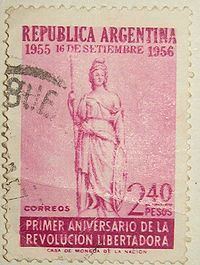Start date September 16, 1955 | ||
 | ||
Part of the Argentine Armed Forces Part of the Argentine Armed Forces Results Peronist government overthrown, military dictatorship seizes power, Eduardo Lonardi becomes acting head of state Similar Bombing of Plaza de Mayo, 1930 Argentine coup d'état, British invasions of the Riv, Conquest of the Desert, Argentine Civil Wars | ||
61a la revoluci n libertadora lonardi 1955 canal encuentro
Revolución Libertadora ([reβoluˈsjon liβertaˈðoɾa]; The Liberating Revolution) was a military and civilian uprising that ended the second presidential term of Juan Perón in Argentina, on 16 September 1955.
Contents
- 61a la revoluci n libertadora lonardi 1955 canal encuentro
- Background
- Revolutionary actions
- Aftermath
- References
Background
President Perón was first elected in 1946. In 1949, a constitutional amendment sponsored by the government introduced a number of workers' rights and the possibility of presidential reelection. Perón was reelected in 1952. At the time, his administration was widely supported by the labor unions, the military and the Catholic Church.
However, economic problems, some of the government's policies and Perón's own personality cult changed this situation. The opposition criticized Perón because of his treatment of dissidents. (Writers, artists, politicians and other intellectuals were harassed and sometimes were forced into exile.) The government's relationship with the Catholic Church also worsened. As the Church increasingly distanced itself from Perón, the government, which had first respected the Church's privileges, now took them away in a distinctly confrontational fashion. By 1954, the Church was openly anti-Peronist, which also influenced some factions of the military. Meanwhile, a Christian Democratic Party was founded in 1954 after several other organisations had been active promoting Christian democracy in Argentina.
By 1955, Perón had lost the support of a large part of the military, who conspired with other political actors (members of the Radical Party and the Socialist Party, as well as conservative groups). There was turmoil in different parts of the country. On June 14, Catholic bishops spoke against Perón during a Corpus Christi procession which turned into an anti-government demonstration.
Revolutionary actions
On 16 June, 30 Argentine Navy and Air Force aircraft bombed Plaza de Mayo, a square in Buenos Aires, killing over 300 civilians and wounding hundreds more. The attack remains to this day the largest aerial bombing ever executed on the Argentine mainland. The bombing targeted the adjacent Casa Rosada, the official seat of government, as a large crowd was gathered there expressing support for president Juan Perón. The strike took place during a day of official public demonstrations to condemn the burning of a national flag allegedly carried out by detractors of Perón during the recent procession of Corpus Christi.
In retaliation, extremist Peronist groups attacked and burned several churches that night, allegedly instigated by Vice-President Alberto Teisaire.
The only important political support for Perón came from the General Confederation of Labour (the main confederation of labor unions), which called the workers to defend the president. Perón addressed a workers' demonstration on 31 August.
On 16 September, a new uprising, led by General Eduardo Lonardi, General Pedro E. Aramburu and Admiral Isaac Rojas, deposed Perón and established a provisional government. For several days, there was some fighting in places like the city of Córdoba (Gen. Lonardi's central command), the Puerto Belgrano Naval Base near Bahía Blanca, another naval base in Río Santiago, and a mechanized infantry regiment in Curuzú Cuatiá, Corrientes Province.
The rebellion in Corrientes, which was initially defeated, was led by Pedro Eugenio Aramburu, who later became one of the main players of the future government. Two rebel destroyers, that were enforcing the blockade of the Río de la Plata, were strafed by loyalist aircraft and suffered some casualties. The city of Mar del Plata was subjected to naval bombardment on 19 September by the light cruiser 9 de Julio and several destroyers, and scattered skirmishes and air strikes took place elsewhere, including Buenos Aires itself.
After realizing that the country was on the brink of civil war, Perón resigned and sought asylum in Paraguay, after taking shelter aboard the Paraguayan gunboat Paraguay.
On 23 September, General Lonardi assumed the presidency and gave a speech from the balcony of the Casa Rosada, saying that there would be "neither victors nor vanquished" (ni vencedores ni vencidos, replaying a phrase uttered by Urquiza when he was victorious over Rosas at the Battle of Caseros). General Lonardi promised that the interim administration would end as soon as the country was "reorganized". His conciliatory tone earned him the opposition of hard-liners, and in November an internal coup deposed Lonardi and placed General Aramburu in the presidency.
Aftermath
After the Revolución Libertadora, Perón and his followers were accused of treason, and Eva Perón's remains were moved secretly to Italy and buried in a graveyard at Milan under a fake identity. Public references to Perón or his late wife, including songs, writings and pictures, were forbidden.
The Peronist Party suffered a proscription that was to last until Perón's return in 1973, even though Perón influenced the results of the 1958 and 1963 elections from his exile in Madrid.
